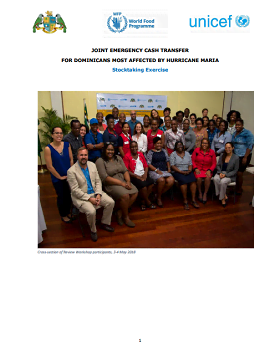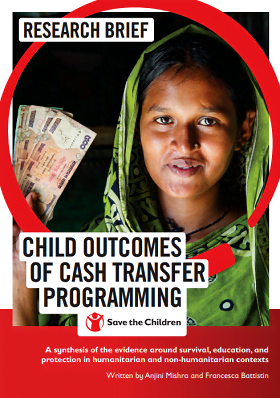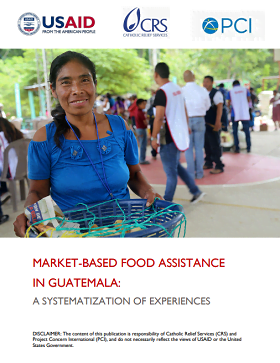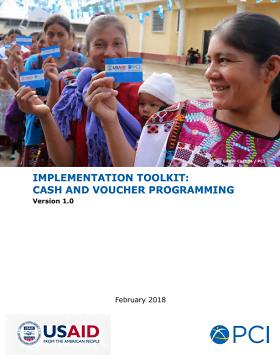Monitoring and Evaluation
Most M&E challenges, such as a lack of sufficient investment and capacities, are not specific to CVA. But those that are relate primarily to monitoring outcomes for unrestricted transfers. The flexibility of cash transfers can make it difficult to determine appropriate outcome indicators, as they may involve a combination of sector-specific and cross-cutting indicators. At the same time, there are limitations on gathering accurate data on how cash transfers are spent.
Grand Bargain signatories have committed to ensuring relevant M&E mechanisms are in place for cash, and increasing understanding of the costs, benefits, impacts and risks of cash relative to other modalities. Building on this, the GB cash workstream has action points including the development of common outcome indicators for multipurpose cash, and metrics for analysing value for money. Systematic value for money analysis has been limited by factors including a lack of agreed upon approaches, the need for quality outcome data, and the intensive nature of the analysis.
Current priorities
As part of the Grand Bargain cash commitments, the CALP Network has co-led (with USAID and CRS) the development of Multipurpose Cash Outcome Indicators. The draft for testing is currently available in English, French and Spanish via the library.
Related initiatives
Featured content

Multipurpose Cash Outcome Indicators – Final Draft for Testing
Guidelines and Tools
Note that the MPC indicators have now been revised. Please click here to access the updated Multipurpose Outcome Indicators and Guidance, which is available in Arabic, English, French and Spanish. Multipurpose Cash Outcome Indicators – Final Draft for Testing Multipurpose cash (MPC) is a type of assistance intended to enable people to meet their basic needs through local...

Monitoring 4 CTP: Monitoring Guidance for CTP in Emergencies
Guidelines and Tools
This guidance provides a central resource to promote a common understanding of the most important monitoring considerations for humanitarian projects using cash transfer programming (CTP). The primary audience for this guidance is field-level practitioners, from organisations directly involved in the design, implementation, monitoring, and accountability of projects using cash and vouchers...

Cost-Efficiency Analysis of Basic Needs Programs: Best Practice Guidance for Humanitarian Agencies
Guidelines and Tools
The Efficiency, Effectiveness and Value for Money Sub-Workstream is pleased to share the final output on Cost-Efficiency Analysis of Basic Needs Programs: Best Practice Guidance for Humanitarian Agencies (attached).
Cost-efficiency analysis estimates the ratio of program costs to outputs created, allowing you to compare cost-per-output for programs which all produced the same output. Such...
Thematic lead
Latest

Review of Food for Peace Market-Based Emergency Food Assistance Programs: Jordan/Turkey Case Study Report
Report
Syria regional crisis: The response to the Syria regional crisis exemplifies the challenges and opportunities involved with delivering food assistance in a widespread, largely urban refugee and internally displaced persons (IDP) crisis affecting middle-income countries. This case study focuses on...

Social Accountability in the Delivery of Social Protection – Ethiopia case study
Report
Social accountability initiatives in two local areas in Ethiopia contributed to improvements in the service delivery of a social protection programme and state-society relations. But the social accountability mechanisms benefited the most marginalised citizens less. A new report by Development Pathways...

Joint Emergency Cash Transfer for Dominicans Most Affected by Hurricane Maria Stocktaking Exercise Report
Report
A workshop was organized in Roseau, Dominica on 3-4 May 2018, to bring together all the stakeholders involved at different levels and stages in the joint Emergency Cash Transfer programme that was implemented from December 2017 to March 2018 as part of the emergency response to Hurricane Maria. The report...

Addressing food insecurity: Does the choice of transfer modality matter?
Report
This operational study analyses the impact of multipurpose cash (MPC)—associated with a nutrition-sensitive training—on the food security and nutrition of the households affected by the drought in the Salvadoran Dry Corridor. Three quantitative and qualitative surveys—with a strong gender...

Review of Food for Peace Market-Based Emergency Food Assistance Programs: Kenya Case Study Report
Report
Kenya represents a country focused on building resilience through greater partnerships between USAID-Food for Peace (FFP) programs, other USAID-funded programs and local and national government. DESIGN: FFP MBEP in Kenya is a good example of connecting emergency and development programming and of...

Child Outcomes of Cash Transfer Programming: Research Brief
Report
Humanitarian emergencies are increasing in both frequency and duration. It is evident that children bear the brunt of these situations and that these experiences have long-lasting effects on their development and future. The figures for the number of children affected by humanitarian emergencies are...

Assessment of the Geographical and Community-based Targeting of WFP’s Cash and Food for Assets Programme in Kenya
Report
This report provides an in-depth assessment of the targeting mechanisms used for the cash and food for assets programme by the World Food Programme (WFP) and the National Drought Management Authority (NDMA). Assessment of the Geographical and Community-based Targeting of WFP’s Cash and Food for Assets...

Market-based Food Assistance in Guatemala: A Systematization of Experiences
Guidelines and Tools
In April 2017, at the request of the United States Agency for International Development’s (USAID) Office of Food for Peace (FFP) in Guatemala, Catholic Relief Services (CRS) and Project Concern International (PCI) designed a process to gather and synthesize the experiences of food assistance...

Human(itarian) Capital? Lessons on Better Connecting Humanitarian Assistance and Social Protection
Report
Governments in low- and middle-income countries are increasingly investing in social protection, and also address many of their own people’s “humanitarian” needs themselves. For their international partners, who may have an important role in filling gaps when household needs exceed national capacity...

Review of Food for Peace Market-Based Emergency Food Assistance Programs: Nigeria Case Study Report
Case Study
Nigeria is an example of food assistance in a conflict situation in the Sahelian context. The response used information technology to deliver one of the more sophisticated applications of voucher programs. This case is a good example of proactive implementing partner (IP) mechanisms and monitoring systems...

Child Outcomes of Cash Transfer Programming: Appendix 1
Report
This is an appendix to the document “Research brief: Child outcomes of cash transfer programming. A synthesis of the evidence around survival, education and protection in humanitarian and non-humanitarian contexts”. This appendix contains the list of studies that were reviewed, with information on...

Transfer Values in Kenya’s National Social Security System
Report
This report, commissioned by the World Food Programme (WFP) and United Nations Children’s Fund (UNICEF) seeks to examine the current transfer values of Kenya’s tax-financed social security schemes and assess whether they are set at an appropriate level. Transfer Values in Kenya’s National Social...

Implementation Toolkit: Cash and Voucher Programming
Guidelines and Tools
This set of tools developed by PCI seeks to harmonize language and approaches for use by teams involved in the design and implementation of cash transfer programs and is not intended to be a complete guide for design and implementation. The tool box focuses on the crucial steps within the program cycle of...

E-Transfer implementation guide
Guidelines and Tools
This updated E-transfer Implementation Guide replaces the original guide published in 2014. In cash transfer programming (CTP), electronic transfers (e-transfers) are a digital replacement for paper vouchers or physical cash. E-transfers are a disbursement mechanism – a way of transferring money, goods...

Review of Food for Peace Market-Based Emergency Food Assistance Programs: Sierra Leone Case Study Report
Report
Sierra Leone represents a remarkable experiment in market-based emergency programming using unconditional cash transfers and some conditional cash transfers Sierra Leone reflects the challenges of providing food assistance in the wake of a major infectious disease epidemic. Food insecurity increased due...

Child Outcomes of Cash Transfer Programming: Appendix 2
Report
This is an appendix to the document “Research brief: Child outcomes of cash transfer programming. A synthesis of the evidence around survival, education and protection in humanitarian and non-humanitarian contexts”. This appendix contains a summary of the available evidence per each outcome of...

Child Vulnerability and Social Protection in Kenya
Report
Kenya’s Social Protection Secretariat has highlighted new evidence showing the need for a universal child grant for Kenyan children. The evidence in Child Vulnerability and Social Protection in Kenya highlights that targeting social protection at orphans, 7.5% of Kenya’s children, with a Cash Transfer...

Review of Food for Peace Market-Based Emergency Food Assistance Programs: Zimbabwe Case Study Report
Report
Zimbabwe reflects the recent Southern African drought crisis during a period of a regional El Niño-related drought and a national cash crisis. The United States Agency for International Development (USAID) Office of Food for Peace (FFP) funded a mix of programming between fiscal years 2011 and 2015,...

Hygiene NFI Provision through Cash Assistance with E-Voucher Modality: PDM
Report
NCA & LWF Gure-shembola Refugee Camp CBI PDM report.

Social Accountability in the Delivery of Social Protection: Technical Guidance Note
Guidelines and Tools
How can citizens better hold social protection officials to account and ensure that they can understand their entitlements? Development Pathways’ research project on social accountability in social protection for the UK’s Department for International Development provides some answers. Social...



